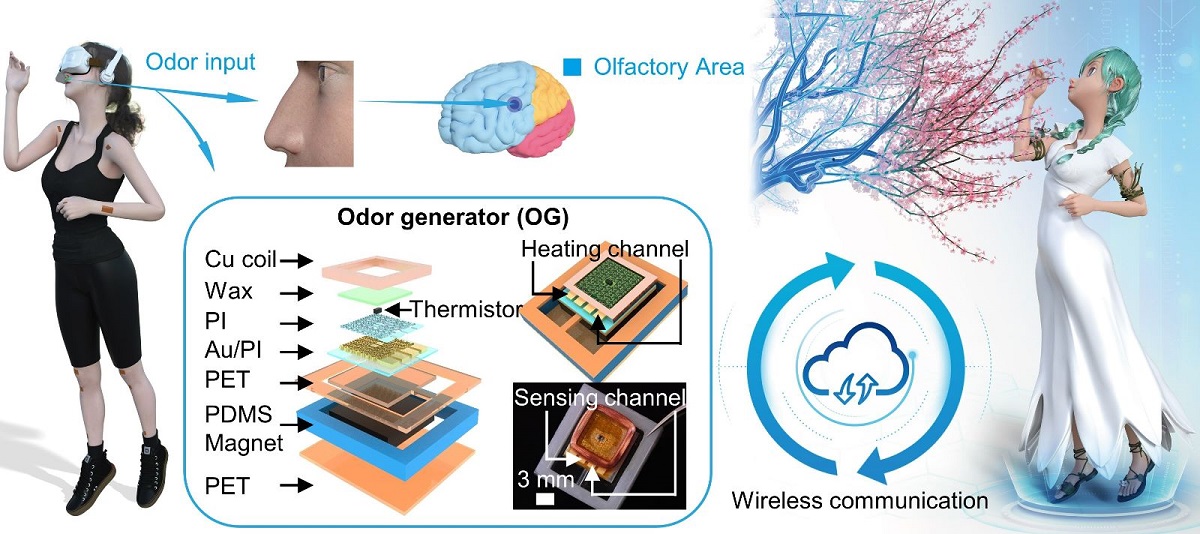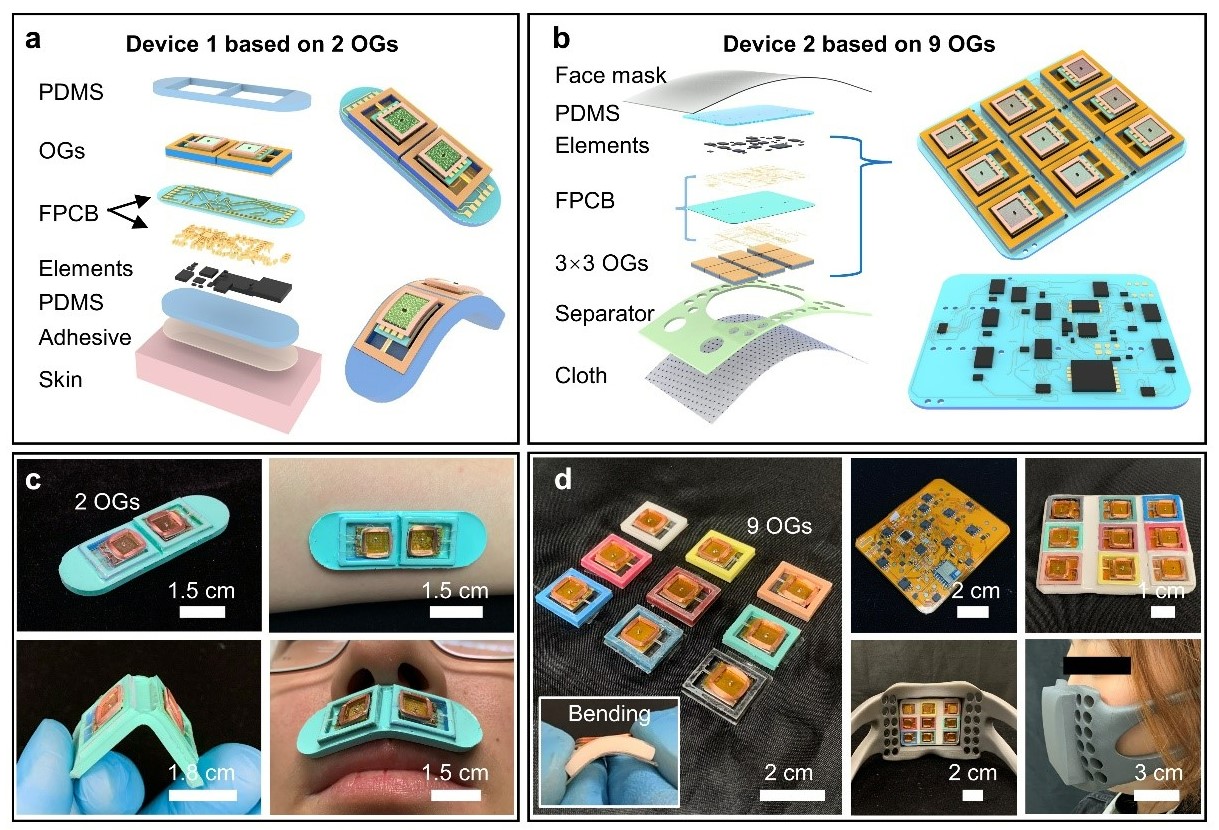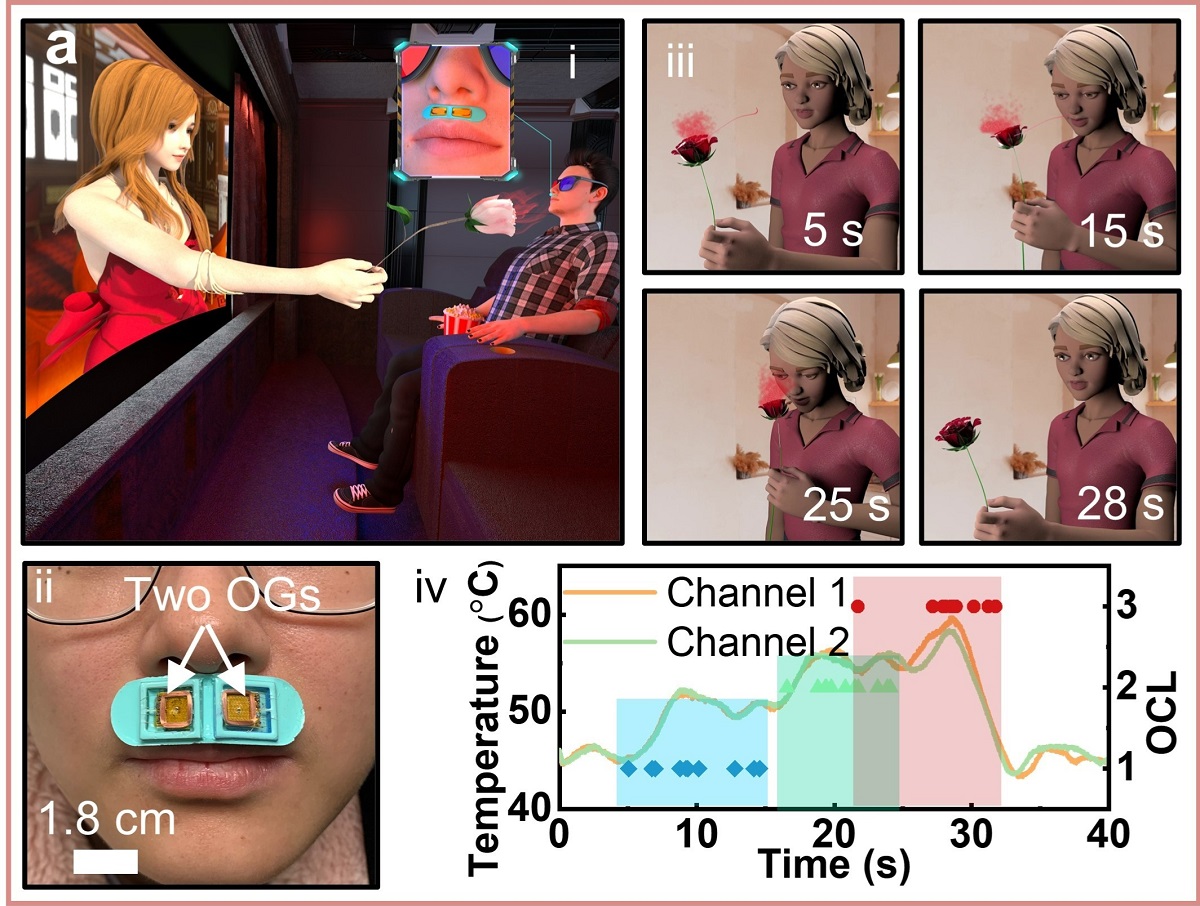CityU invents wireless olfactory feedback system to let users smell in the VR world
A research team co-led by researchers from City University of Hong Kong (CityU) recently invented a novel, wireless, skin-interfaced olfactory feedback system that can release various odours with miniaturised odour generators (OGs). The new technology integrates odours into virtual reality (VR)/augmented reality (AR) to provide a more immersive experience, with broad applications ranging from 4D movie watching and medical treatment to online teaching.
“Recent human machine interfaces highlight the importance of human sensation feedback, including vision, audio and haptics, associated with wide applications in entertainment, medical treatment and VR/AR. Olfaction also plays a significant role in human perceptual experiences,” said Dr Yu Xinge, Associate Professor in the Department of Biomedical Engineering at CityU, who co-led the study. “However, the current olfaction-generating technologies are associated mainly with big instruments to generate odours in a closed area or room, or an in-built bulky VR set.”
In view of this, Dr Yu and his collaborators from Beihang University developed a new-generation, wearable, olfaction feedback system with wireless, programmable capabilities based on arrays of flexible and miniaturised odour generators.
Demonstration of the application of the skin-integrated device for 4D movie watching. Credit: Liu, Y. et al, https://www.nature.com/articles/s41467-023-37678-4
They created two designs to release odours on demand through the new olfaction feedback devices, which are made of soft, miniaturised, lightweight substrates. The first one is a small, skin-integrated, patch-like device comprising two OGs, which can be directly mounted on the human upper lip. With an extremely short distance between the OGs and the user’s nose, it can provide an ultra-fast olfaction response. Another design is a flexible facemask design with nine OGs of different odour types, which can provide hundreds of odour combinations.

The magic of odour generators is based on a subtle heating platform and a mechanical thermal actuator. By heating and melting odorous paraffin wax on OGs to cause phase change, different odours of adjustable concentration are released. To stop the odour, the odour generators can cool down the temperature of the wax by controlling the motion of the thermal actuato.

Photo credit: Liu, Y. et al, https://www.nature.com/articles/s41467-023-37678-4
By using different paraffin waxes, the research team was able to make about 30 different scents in total, from herbal rosemary and fruity pineapple to sweet baked pancakes. Even less-than-pleasant scents, like stinky durian, can be created. The 11 volunteers were able to recognise the scents generated by the OGs with an average success rate of 93 percent.
The new system supports long-term utilisation without frequent replacement and maintenance, and enables interaction with users for various applications. Most importantly, the olfactory interface can support wireless and programmable operation, and can interact with users in various applications. It can respond rapidly to burst or suppress odours and for accurate odour concentration control. And the odour sources are easily accessible and biocompatible.
Demonstration of the application of the face mask device in a VR game. Credit: Liu, Y. et al, https://www.nature.com/articles/s41467-023-37678-4

Device 2 has 9 OGs inside the face mask, which can work independently (eii) or together (eiii).
Photo credit: Liu, Y. et al, https://www.nature.com/articles/s41467-023-37678-4
In their experiments, demonstrations in 4D movie watching, medical treatment, human emotion control and VR/AR experience in online teaching exhibited the great potential of the new olfaction interfaces in various applications.
For instance, the new wireless olfaction system can interact between the user and a virtual subject when the user is “walking” in a virtual garden by releasing various fruit fragrances. The new technology also showed potential for helping amnesic patients recall lost memories, as odour perception is modulated by experience, leading to the recall of emotional memories.
“The new olfaction systems provide a new alternative option for users to realise the olfaction display in a virtual environment. The fast response rate in releasing odours, the high odour generator integration density, and two wearable designs ensure great potential for olfaction interfaces in various applications, ranging from entertainment and education to healthcare and human machine interfaces,” said Dr Yu.
In the next step, he and his research team will focus on developing a next-generation olfaction system with a shorter response time, smaller size, and higher integration density for VR, AR and mixed reality (MR) applications.
The findings were published in the scientific journal Nature Communications under the title “Soft, Miniaturized, Wireless Olfactory Interface for Virtual Reality”.
The corresponding authors are Dr Yu and Dr Li Yuhang from the Institute of Solid Mechanics at Beihang University. The first co-authors are Dr Liu Yiming, a postdoc on Dr Yu’s research team, Mr Yiu Chunki and Mr Wooyoung Park, PhD students supervised by Dr Yu, and Dr Zhao Zhao, a postdoc on Dr Li’s research team.
The research was supported mainly by the National Natural Science Foundation of China, CityU, and the Research Grants Council of the HKSAR.
